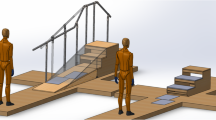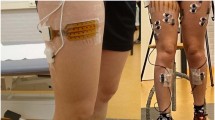Abstract
To perform seamless transitions in powered lower limb prostheses, accurate classification of transition type is required a priori. We propose a structure to detect direction (ascent or descent) and terrain (ramp or stairs) patterns when a person transitions from over ground to stairs or ramp locomotion. We compared electromyography (EMG) and accelerometry performance with an emphasis on sensor fusion for improving classification. Seven healthy subjects were recruited for this initial study. Data were collected with accelerometers and EMG electrodes on the dominant leg, while subjects transitioned from over ground to ramp (ascent and descent) and stair (ascent and descent) locomotion. Linear discriminant analysis and support vector machine approaches were used as classifiers using feature spaces of both sensor types. The results indicate that transitions are better classified as terrain type than direction type (p < 0.001), suggesting a terrain focused approach for an efficient structure. We also show that EMG and accelerometry data sources are complementary across the transitional gait cycle, suggesting sensor fusion for robust classification. These findings suggest that a terrain and direction focused classification approach will be useful for inclusion in classification approaches utilized in lower limb amputee samples.






Similar content being viewed by others
References
Au, S., M. Berniker, and H. Herr. Powered ankle-foot prosthesis to assist level-ground and stair-descent gaits. Neural Netw. 21:654–666, 2008.
Bao, L., and S. S. Intille. Activity Recognition from User-annotated Acceleration Data. Pervasive (LCNS 3001), Berlin: Springer, 2004.
Bliss, C. I. The method of probits. Science 79:38–39, 1934.
Chowdhury, R. H., M. B. Reaz, M. A. Ali, A. A. Bakar, K. Chellappan, and T. G. Chang. Surface electromyography signal processing and classification techniques. Sensors (Basel) 13:12431–12466, 2013.
Delagi, E. F., and A. Perotto. Anatomic Guide for the Electromyographer—The Limbs (2nd ed.)., Vol. xvi. Springfield: Thomas, 1980.
Dillingham, T., L. Pezzin, and E. J. Mackenzie. Limb amputation and limb deficiency: epidemiology and recent trends in the united states. South. Med. J. 95:875–883, 2002.
Englehart, K., and B. Hudgins. A robust, real-time control scheme for multifunction myoelectric control. IEEE Trans. Biomed. Eng. 50:848–854, 2003.
Graupe, D., J. Salahi, and K. H. Kohn. Multifunctional prosthesis and orthosis control via microcomputer identification of temporal pattern differences in single-site myoelectric signals. J. Biomed. Eng. 4:17–22, 1982.
Gupta, P., and T. Dallas. Feature selection and activity recognition system using a single triaxial accelerometer. IEEE Trans. Biomed. Eng. 61:1780–1786, 2014.
Huang, H., T. A. Kuiken, and R. D. Lipschutz. A strategy for identifying locomotion modes using surface electromyography. IEEE Trans. Biomed. Eng. 56:65–73, 2009.
Huang, H., F. Zhang, L. J. Hargrove, Z. Dou, D. R. Rogers, and K. B. Englehart. Continuous locomotion-mode identification for prosthetic legs based on neuromuscular-mechanical fusion. IEEE Trans. Biomed. Eng. 58:2867–2875, 2011.
Huang, H., P. Zhou, G. Li, and T. A. Kuiken. An analysis of EMG electrode configuration for targeted muscle reinnervation based neural machine interface. IEEE Trans. Neural Syst. Rehabil. Eng. 16:37–45, 2008.
Joshi, D., B. Nakamura, and M. Hahn. A novel approach for toe off estimation during locomotion and transitions on ramps and level ground. IEEE J. Biomed. Health Inform. 2014. doi:10.1109/JBHI.2014.2377749.
Kumar, S., J. Ghosh, and M. M. Crawford. Hierarchical fusion of multiple classifiers for hyperspectral data analysis. Pattern Anal. Appl. 5:210–220, 2002.
Miller, J. D., M. S. Beazer, and M. E. Hahn. Myoelectric walking mode classification for transtibial amputees. IEEE Trans. Biomed. Eng. 60:2745–2750, 2013.
Oskoei, M. A., and H. Hu. Support vector machine-based classification scheme for myoelectric control applied to upper limb. IEEE Trans. Biomed. Eng. 55:1956–1965, 2008.
Sejdic, E., K. A. Lowry, J. Bellanca, M. S. Redfern, and J. S. Brach. A comprehensive assessment of gait accelerometry signals in time, frequency and time-frequency domains. IEEE Trans. Neural Syst. Rehabil. Eng. 22:603–612, 2014.
Silla, C. N., and A. A. Freitas. A survey of hierarchical classification across different application domains. Data Min. Knowl. Discov. 22:31–72, 2011.
Sup, F., A. Bohara, and M. Goldfarb. Design and control of a powered transfemoral prosthesis. Int. J. Robot. Res. 27:263–273, 2008.
Tkach, D. C., and L. J. Hargrove. Neuromechanical sensor fusion yields highest accuracies in predicting ambulation mode transitions for trans-tibial amputees. Conf. Proc. IEEE Eng. Med. Biol. Soc. 3074–3077:2013, 2013.
Young, A. J., A. M. Simon, and L. J. Hargrove. A training method for locomotion mode prediction using powered lower limb prostheses. IEEE Trans. Neural Syst. Rehabil. Eng. 22:671–677, 2014.
Yuan, K., Q. Wang, and L. Wang. Fuzzy-logic-based terrain identification with multisensor fusion for transtibial amputees. IEEE/ASME Trans. Mechtron. 20:618–630, 2015.
Ziegler-Graham, K., E. J. Mackenzie, P. L. Ephraim, T. G. Travison, and R. Brookmeyer. Estimating the prevalence of limb loss in the united states: 2005 to 2050. Arch. Phys. Med. Rehabil. 89:422–429, 2008.
Acknowledgments
This work was supported by the Department of Defense under Grant W81XWH-09-2-0144. The authors are grateful to Bryson Nakamura and Eileen Deming for their help in data collection and post-processing.
Conflict of interest
The authors’ institution received grant sub-contract funds from the Seattle Institute of Biomedical and Clinical Research. This work is associated with a Patent PCT/US2014/045608 pending.
Author information
Authors and Affiliations
Corresponding author
Additional information
Associate Editor Michael R. Torry oversaw the review of this article.
Rights and permissions
About this article
Cite this article
Joshi, D., Hahn, M.E. Terrain and Direction Classification of Locomotion Transitions Using Neuromuscular and Mechanical Input. Ann Biomed Eng 44, 1275–1284 (2016). https://doi.org/10.1007/s10439-015-1407-3
Received:
Accepted:
Published:
Issue Date:
DOI: https://doi.org/10.1007/s10439-015-1407-3




